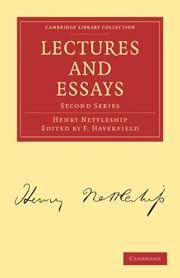Book contents
- Frontmatter
- PREFACE
- Contents
- Dedication
- MEMOIR BY MRS. NETTLESHIP
- I JOHAN NICOLAI MADVIG
- II THE ORIGINAL FORM OF THE ROMAN SATURA
- III LITERARY CRITICISM IN LATIN ANTIQUITY
- IV THE HISTORICAL DEVELOPMENT OF CLASSICAL LATIN PROSE
- V LIFE AND POEMS OF JUVENAL
- VI THE STUDY OF LATIN GRAMMAR AMONG THE ROMANS IN THE FIRST CENTURY A. D.
- VII ON THE PRESENT RELATIONS BETWEEN CLASSICAL RESEARCH AND CLASSICAL EDUCATION IN ENGLAND
- VIII THE MORAL INFLUENCE OF LITERATURE
- IX CLASSICAL EDUCATION IN THE PAST AND AT PRESENT
- X AUTHORITY IN THE SPHERE OF CONDUCT AND INTELLECT
- XI THE RELATIONS BETWEEN NATURAL SCIENCE AND LITERATURE
- BIBLIOGRAPHY
- INDEX
IV - THE HISTORICAL DEVELOPMENT OF CLASSICAL LATIN PROSE
Published online by Cambridge University Press: 05 October 2010
- Frontmatter
- PREFACE
- Contents
- Dedication
- MEMOIR BY MRS. NETTLESHIP
- I JOHAN NICOLAI MADVIG
- II THE ORIGINAL FORM OF THE ROMAN SATURA
- III LITERARY CRITICISM IN LATIN ANTIQUITY
- IV THE HISTORICAL DEVELOPMENT OF CLASSICAL LATIN PROSE
- V LIFE AND POEMS OF JUVENAL
- VI THE STUDY OF LATIN GRAMMAR AMONG THE ROMANS IN THE FIRST CENTURY A. D.
- VII ON THE PRESENT RELATIONS BETWEEN CLASSICAL RESEARCH AND CLASSICAL EDUCATION IN ENGLAND
- VIII THE MORAL INFLUENCE OF LITERATURE
- IX CLASSICAL EDUCATION IN THE PAST AND AT PRESENT
- X AUTHORITY IN THE SPHERE OF CONDUCT AND INTELLECT
- XI THE RELATIONS BETWEEN NATURAL SCIENCE AND LITERATURE
- BIBLIOGRAPHY
- INDEX
Summary
Were any one asked who in his opinion were the main representatives of Latin Prose style, there can I suppose be little doubt that he would mention Cicero, Livy, and Tacitus. These three names, in fact, mark three definite stages in the development of classical Latin Prose. To speak more accurately, there are two stages, each of which marks the extreme point of a line of tendency. These stages are represented respectively by the styles of Cicero and of Tacitus, between whom Livy, who has a manner peculiar to himself, occupies the middle place.
The elements of a good style are two, luminousness and beauty. By luminousness I mean its power of representing thought and passion. To express thought it must be lucid, to represent thought and passion it must be simple and strong. By beauty I mean such a choice of words, and such an arrangement of them, as satisfies the requirements of the ear.
In a masterly style these two elements are combined in a manner which is felt to defy dissection, and to require none. The impression produced is one and indivisible, and we do not care to analyze it. Such a passage as the conclusion of Cicero's second Philippic speaks home to us with a living impression of unity and directness which we acknowledge without question. We admire and ask for nothing more.
- Type
- Chapter
- Information
- Lectures and EssaysSecond Series, pp. 93 - 116Publisher: Cambridge University PressPrint publication year: 2010First published in: 1895

